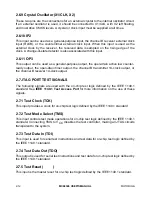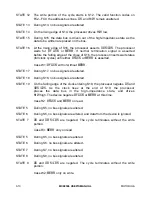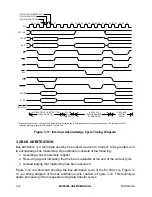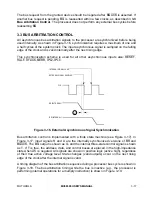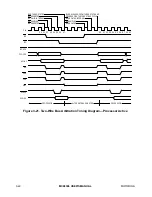
MOTOROLA
MC68306 USER'S MANUAL
3- 7
The descriptions of the eight states of a write cycle are as follows:
STATE 0
The write cycle starts in S0. The processor places valid function codes on
FC2–FC0, a valid address on the address bus, and drives R/
W
high (if
a preceding write cycle has left R/
W
low).
STATE 1
During S1, no bus signals are altered.
STATE 2
On the rising edge of S2, the processor asserts
AS
and drives R/
W
low.
STATE 3
During S3, the data bus is driven out of the high-impedance state as the
data to be written is placed on the bus.
STATE 4
At the rising edge of S4, the processor asserts
U D S
and/or
LDS;.
The
processor waits for a cycle termination signal (
DTACK
or
BERR
). If
neither termination signal is asserted before the falling edge at the end of
S4, the processor inserts wait states (full clock cycles) until either
DTACK
or
BERR
is asserted.
Case 1:
DTACK
received, with or without
BERR
.
STATE 5
During S5, no bus signals are altered.
STATE 6
During S6, no bus signals are altered.
STATE 7
On the falling edge of the clock entering S7, the processor negates
A S
,
UDS
, and/or
LDS
. As the clock rises at the end of S7, the processor places
the data bus in the high-impedance state, and drives R/
W
high. The device negates
DTACK
or
BERR
at this time.
Case 2:
BERR
received without
DTACK
.
STATE 5
During state 5 (S5), no bus signals are altered.
STATE 6
During state 6 (S6), no bus signals are altered.
STATE 7
During state 7 (S7), no bus signals are altered.
STATE 8
During state 8 (S8), no bus signals are altered.
STATE 9
AS
and
UDS/LDS
negated. Slave negates
BERR.
At the end of S9, three-
state data and drive R/
W
high.
3.1.3 Read-Modify-Write Cycle
The read-modify-write cycle performs a read operation, modifies the data in the arithmetic
logic unit, and writes the data back to the same address. The address strobe (
AS
) remains
asserted throughout the entire cycle, making the cycle indivisible. The test and set (TAS)
instruction uses this cycle to provide a signaling capability without deadlock between
processors in a multiprocessing environment. The TAS instruction (the only instruction








